Choosing the right security cameras for your business can feel overwhelming, but it doesn’t have to be. Dome cameras, bullet cameras, PTZ (pan-tilt-zoom) cameras, and fisheye cameras each serve a unique purpose, helping you keep an eye on everything from entrances to wide-open spaces. Whether you need high-definition footage, night vision, or remote control features, understanding your options ensures you get the best protection. Let’s break down the different types of CCTV security cameras so you can find the perfect fit for your business.
Table of Contents
Toggle- Most common types of CCTV security cameras
- Types of CCTV security cameras by shape
- Types of CCTV security camera connectivity
- Types of CCTV security cameras by environment
- Specialty features of CCTV security cameras
- Choosing the right CCTV security cameras for your business
- CCTV security cameras are only as good as the VMS you pair with them
Most common types of CCTV security cameras
Some of the most common CCTV security cameras you will see existing in business today are:
By form or shape type:
- Dome cameras
- Bullet cameras
- PTZ (Pan, Tilt, Zoom) cameras
- Turret cameras
- Fisheye cameras
- Wired CCTV cameras
- Wireless CCTV cameras
- IP or network CCTV security cameras
By environment type:
- Indoor CCTV cameras
- Outdoor CCTV cameras
By specialty features:
- Infrared (night vision) cameras
- Thermal imaging cameras
- Varifocal cameras
- ANPR and LPR cameras
Types of CCTV security cameras by shape
The shape of a CCTV security camera affects how well it blends in, how much area it covers, and how effectively it deters crime. Dome cameras are compact and discreet, making them harder to tamper with while providing wide-angle coverage. Bullet cameras, with their long, cylindrical shape, are more noticeable, which can discourage potential threats. PTZ cameras can move and zoom, offering flexible coverage for large areas. Fisheye cameras provide a 360° view, eliminating blind spots. The right shape ensures the camera meets your security needs while fitting seamlessly into your business environment.
Dome cameras
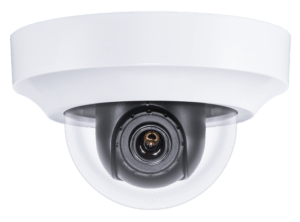 Dome cameras are a popular choice for businesses due to their discreet design and wide-angle coverage. Their dome-shaped casing makes it difficult to see where the camera is pointing, deterring potential threats. These cameras are durable, often vandal-resistant, and work well indoors and outdoors. Many models offer features like infrared night vision, high-definition resolution, and motion detection. Ideal for retail stores, offices, and restaurants, dome cameras provide reliable security while blending seamlessly into their surroundings.
Dome cameras are a popular choice for businesses due to their discreet design and wide-angle coverage. Their dome-shaped casing makes it difficult to see where the camera is pointing, deterring potential threats. These cameras are durable, often vandal-resistant, and work well indoors and outdoors. Many models offer features like infrared night vision, high-definition resolution, and motion detection. Ideal for retail stores, offices, and restaurants, dome cameras provide reliable security while blending seamlessly into their surroundings.
Dome cameras offer discreet, wide-angle security footage for various business settings. Common uses include:
- Retail stores – Monitor aisles and deter theft.
- Offices – Oversee workspaces and entry points.
- Restaurants – Keep an eye on dining areas and cash registers.
- Hotels – Enhance lobby and hallway security.
- Hospitals – Ensure safety in waiting rooms and corridors.
- Apartment buildings – Watch over lobbies and shared spaces.
Their tamper-resistant design and broad coverage make them ideal for indoor and outdoor use.
Bullet cameras
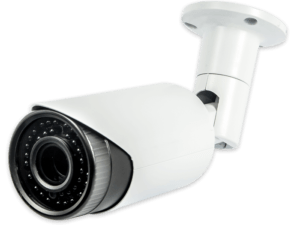 Bullet cameras are a highly visible security solution, making them an effective deterrent for crime. Their long, cylindrical shape allows for extended-range viewing, making them ideal for monitoring parking lots, building exteriors, and large open areas. These cameras are often weatherproof, built to withstand harsh conditions, and equipped with features like infrared night vision and high-definition resolution. Easy to install and adjust, bullet cameras provide clear, focused security for businesses that need strong perimeter protection.
Bullet cameras are a highly visible security solution, making them an effective deterrent for crime. Their long, cylindrical shape allows for extended-range viewing, making them ideal for monitoring parking lots, building exteriors, and large open areas. These cameras are often weatherproof, built to withstand harsh conditions, and equipped with features like infrared night vision and high-definition resolution. Easy to install and adjust, bullet cameras provide clear, focused security for businesses that need strong perimeter protection.
Bullet cameras are perfect for long-range monitoring and crime deterrence. Common uses include:
- Parking lots – Capture vehicle activity and deter theft.
- Building exteriors – Monitor entry points and loading docks.
- Warehouses – Protect large storage areas.
- Gas stations – Watch over pumps and storefronts.
- Farms – Secure livestock and equipment.
- Retail storefronts – Prevent shoplifting and vandalism.
Their weatherproof build and extended range make them ideal for outdoor security.
PTZ (Pan, Title, Zoom) cameras
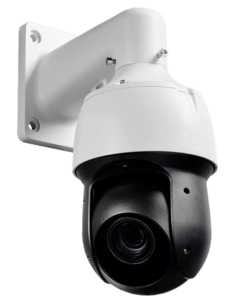 PTZ cameras offer dynamic security with remote control capabilities, allowing businesses to pan, tilt, and zoom for flexible coverage. These cameras are ideal for monitoring large areas like parking lots, warehouses, stadiums, and shopping malls. Security teams can adjust angles and zoom in on details in real time, making them perfect for high-traffic or high-risk locations. With features like motion tracking and preset patrol routes, PTZ cameras provide comprehensive, adaptable security for businesses needing active monitoring.
PTZ cameras offer dynamic security with remote control capabilities, allowing businesses to pan, tilt, and zoom for flexible coverage. These cameras are ideal for monitoring large areas like parking lots, warehouses, stadiums, and shopping malls. Security teams can adjust angles and zoom in on details in real time, making them perfect for high-traffic or high-risk locations. With features like motion tracking and preset patrol routes, PTZ cameras provide comprehensive, adaptable security for businesses needing active monitoring.
PTZ cameras provide flexible, high-coverage security with remote control movement. Common uses include:
- Large warehouses – Monitor inventory and track movement.
- Parking lots – Zoom in on vehicles and license plates.
- Casinos – Track suspicious activity in real time.
- Stadiums – Cover large crowds with adjustable angles.
- Airports – Enhance security with wide-area footage.
- Shopping malls – Focus on high-traffic areas and entry points.
Their ability to pan, tilt, and zoom makes them ideal for dynamic, large-area monitoring.
Their weatherproof build and extended range make them ideal for outdoor security.
Turret cameras
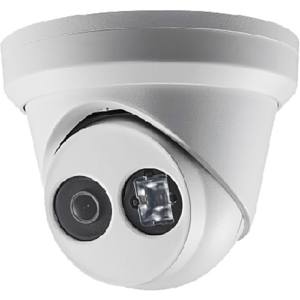 Turret cameras provide flexible positioning and clear video quality, making them a reliable choice for businesses. Their ball-and-socket design allows for easy angle adjustments without the glare issues of dome cameras. Ideal for both indoor and outdoor use, they are commonly found in retail stores, offices, and parking lots. Many models feature infrared night vision, high-definition resolution, and weather-resistant casings. With a compact yet visible design, turret cameras offer strong security without being overly intrusive.
Turret cameras provide flexible positioning and clear video quality, making them a reliable choice for businesses. Their ball-and-socket design allows for easy angle adjustments without the glare issues of dome cameras. Ideal for both indoor and outdoor use, they are commonly found in retail stores, offices, and parking lots. Many models feature infrared night vision, high-definition resolution, and weather-resistant casings. With a compact yet visible design, turret cameras offer strong security without being overly intrusive.
Turret cameras offer versatile, high-quality footage for various business settings. Common uses include:
- Retail stores – Monitor aisles and checkout areas.
- Offices – Oversee workspaces and entry points.
- Parking lots – Capture clear footage without glare.
- Restaurants – Keep an eye on dining areas and registers.
- Warehouses – Watch over inventory and loading docks.
- Apartment buildings – Secure lobbies and common areas.
Their adjustable design and reliable performance make them ideal for indoor and outdoor security.
360 or fisheye cameras
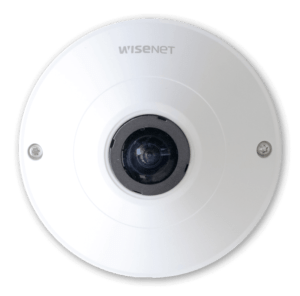 Fisheye cameras provide 360° video footage, eliminating blind spots with a single device. Their ultra-wide-angle lens makes them ideal for monitoring large areas like retail stores, warehouses, offices, and lobbies. Businesses use them to cover expansive spaces without needing multiple cameras, reducing installation costs. Many models offer dewarping technology, allowing users to view footage in different formats for better clarity. With a compact design and broad coverage, fisheye cameras deliver efficient, all-encompassing security.
Fisheye cameras provide 360° video footage, eliminating blind spots with a single device. Their ultra-wide-angle lens makes them ideal for monitoring large areas like retail stores, warehouses, offices, and lobbies. Businesses use them to cover expansive spaces without needing multiple cameras, reducing installation costs. Many models offer dewarping technology, allowing users to view footage in different formats for better clarity. With a compact design and broad coverage, fisheye cameras deliver efficient, all-encompassing security.
Fisheye cameras provide 360° coverage, making them ideal for wide-area security footage. Common uses include:
- Retail stores – Monitor entire sales floors with one camera.
- Warehouses – Cover large storage areas without blind spots.
- Offices – Oversee open workspaces and entry points.
- Lobbies – Watch over high-traffic areas in hotels and businesses.
- Schools – Enhance security in hallways and common areas.
- Restaurants – Keep an eye on dining areas and cash registers.
Their all-in-one coverage reduces the need for multiple cameras, cutting costs and improving efficiency.
Types of CCTV security camera connectivity
Connectivity is crucial for CCTV security cameras because it determines how footage is transmitted, stored, and accessed. A reliable connection ensures real-time monitoring, remote access, and smooth video playback without lag or loss. Choosing the right connectivity ensures seamless security, reliable footage storage, and quick access to critical video when needed.
Wired CCTV security cameras
Wired CCTV security camera systems provide a stable and reliable security solution for businesses. These systems use physical cables to transmit video and power, ensuring consistent footage without interference or signal loss. Ideal for large properties, warehouses, and high-security areas, wired cameras offer higher video quality and more secure data transmission than wireless options. They also integrate easily with on-site storage systems, reducing reliance on internet connections. While installation requires more effort, the long-term reliability and uninterrupted performance make wired CCTV systems a strong choice for businesses needing 24/7 security.
Wired CCTV systems use different types of cables to transmit power and video, each suited for specific needs. Coaxial cables (like RG59) are common in analog systems, delivering video signals but requiring a separate power source. Ethernet cables (Cat5e, Cat6) are used in IP camera systems, supporting high-definition video and network connectivity. Many businesses prefer Power over Ethernet (PoE), which allows a single Ethernet cable to transmit both power and data, simplifying installation and reducing cable clutter. Choosing the right cabling ensures reliable performance, clear video quality, and seamless integration with existing security infrastructure.
Common wired CCTV camera shapes can include:
- Dome cameras
- Bullet cameras
- Turret cameras
- PTZ cameras
- Box cameras
These shapes offer reliable, high-quality video transmission when paired with wired connections, ensuring stable security coverage.
Wireless CCTV security cameras
Wireless CCTV security cameras transmit video and audio without physical cables, using Wi-Fi or radio signals instead. They offer flexible installation, making them ideal for businesses that need quick setup or want to avoid extensive wiring. Many models support cloud storage, remote access, and smart integrations, allowing users to monitor footage from anywhere. However, they rely on strong network connections to ensure smooth video transmission and may require regular battery changes or a power source. Wireless cameras are best for small businesses, offices, and temporary security needs.
Common wireless CCTV camera shapes can include:
- Dome cameras
- Bullet cameras
- Turret cameras
- PTZ cameras
- Fisheye cameras
These shapes provide versatile security options while eliminating the need for extensive wiring.
IP or network CCTV security cameras
An IP camera isn’t its own physical type—it refers to how the camera transmits and processes video. IP (network) cameras can come in different shapes, such as dome, bullet, turret, PTZ, or fisheye, and what makes them “IP” is their ability to connect to a network via Ethernet or Wi-Fi.
The key difference is in the technology inside—IP cameras use digital processing to send video data over a network, allowing remote access, cloud storage, and smart analytics. Traditional analog cameras, on the other hand, require a DVR (Digital Video Recorder) and coaxial cables.
IP cameras are now the most widely used connection type, espcially when it comes to connecting to a VMS (video management software) like Solink, because they offer better video quality, remote access, and smart features compared to older analog systems.
Types of CCTV security cameras by environment
Choosing the right CCTV camera depends on where it will be used. Indoor cameras focus on discreet monitoring, while outdoor models are built to withstand harsh weather. Some cameras are designed for low-light conditions, high-risk areas, or even hazardous environments. Understanding these differences ensures you get the best security for your business.
Indoor CCTV security cameras
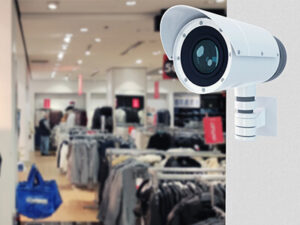 Indoor security cameras are designed for offices, retail stores, restaurants, and other indoor spaces where discreet, high-quality security is needed. These cameras are typically compact, offering wide-angle views to cover more area with fewer devices. Many models include features like motion detection, two-way audio, and smart integration for remote monitoring. Since they don’t need weatherproofing, they are often more affordable and easier to install. Ideal for monitoring entry points, cash registers, stockrooms, and customer areas, indoor cameras help businesses prevent theft, improve operations, and enhance overall security.
Indoor security cameras are designed for offices, retail stores, restaurants, and other indoor spaces where discreet, high-quality security is needed. These cameras are typically compact, offering wide-angle views to cover more area with fewer devices. Many models include features like motion detection, two-way audio, and smart integration for remote monitoring. Since they don’t need weatherproofing, they are often more affordable and easier to install. Ideal for monitoring entry points, cash registers, stockrooms, and customer areas, indoor cameras help businesses prevent theft, improve operations, and enhance overall security.
Outdoor CCTV security cameras
 Outdoor security cameras are built to withstand harsh weather conditions while providing clear, reliable monitoring. These cameras are typically weatherproof and durable, protecting against rain, heat, and cold. Many models include infrared night vision, motion detection, and high-definition resolution to capture details in any lighting. They are ideal for parking lots, building entrances, loading docks, and perimeters, helping businesses deter theft, monitor activity, and improve safety. With sturdy housings and long-range capabilities, outdoor cameras ensure 24/7 protection for your property.
Outdoor security cameras are built to withstand harsh weather conditions while providing clear, reliable monitoring. These cameras are typically weatherproof and durable, protecting against rain, heat, and cold. Many models include infrared night vision, motion detection, and high-definition resolution to capture details in any lighting. They are ideal for parking lots, building entrances, loading docks, and perimeters, helping businesses deter theft, monitor activity, and improve safety. With sturdy housings and long-range capabilities, outdoor cameras ensure 24/7 protection for your property.
Specialty features of CCTV security cameras
CCTV security cameras come with a range of specialty features designed to enhance security and adapt to specific needs. From night vision for low-light areas to thermal imaging for detecting heat signatures, these features improve security in different environments. Businesses can also benefit from license plate recognition (LPR), motion tracking, and two-way audio, making security systems smarter and more efficient. Understanding these advanced capabilities helps businesses choose the right cameras for their unique security challenges.
Infrared (night vision) cameras
Infrared (night vision) cameras capture clear footage in low-light or complete darkness using infrared (IR) LEDs. These cameras automatically switch to night mode when lighting drops, making them ideal for parking lots, alleys, warehouses, and perimeter security. They come in various shapes, including dome, bullet, and PTZ, and are commonly used for 24/7 monitoring. With the ability to detect motion and details even in pitch-black conditions, infrared cameras provide reliable security day and night.
Thermal imaging cameras
Thermal imaging cameras detect heat signatures instead of visible light, making them ideal for security in total darkness, fog, or smoke. They are commonly used in high-risk areas like industrial sites, airports, and perimeter security, where detecting people or vehicles is critical. Unlike infrared night vision, which relies on light, thermal cameras work in all lighting conditions, identifying heat differences to spot intruders or equipment malfunctions. Businesses use them for enhanced security, fire detection, and monitoring restricted areas.
Varifocal cameras
Varifocal cameras have adjustable lenses that allow users to zoom in or out without losing focus. This flexibility makes them ideal for businesses that need to monitor both wide areas and specific details, such as entrances, parking lots, or cash registers. Unlike fixed-lens cameras, varifocal models provide greater control over the field of view, making them useful for locations where security needs may change over time. They are available in dome, bullet, and turret designs and often include features like autofocus and night vision for clear, adaptable security.
ANPR and LPR cameras
ANPR (Automatic Number Plate Recognition) and LPR (License Plate Recognition) cameras are specialized security cameras designed to capture and read vehicle license plates. They use advanced image processing to recognize plate numbers, even in low light or high-speed conditions. These cameras are commonly used in parking lots, toll booths, gated communities, and law enforcement to track vehicles, manage access, and enhance security. Businesses benefit from improved traffic monitoring, automated entry systems, and accurate record-keeping of vehicle activity.
Choosing the right CCTV security cameras for your business
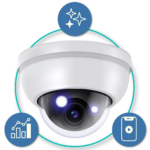 Choosing the right CCTV security cameras for your business depends on your security needs, location, and budget. Consider whether you need indoor or outdoor cameras, wired or wireless connectivity, and features like night vision, motion detection, or remote access. The type of business also matters—retail stores may need wide-angle dome cameras, while warehouses benefit from PTZ or bullet cameras for long-range monitoring. Understanding your security goals ensures you select the right cameras to protect your business, employees, and assets effectively.
Choosing the right CCTV security cameras for your business depends on your security needs, location, and budget. Consider whether you need indoor or outdoor cameras, wired or wireless connectivity, and features like night vision, motion detection, or remote access. The type of business also matters—retail stores may need wide-angle dome cameras, while warehouses benefit from PTZ or bullet cameras for long-range monitoring. Understanding your security goals ensures you select the right cameras to protect your business, employees, and assets effectively.
Top tips for CCTV security cameras and your business
- Assess your security needs – Identify key areas to monitor, like entrances, parking lots, or cash registers.
- Choose the right camera type – Dome for discretion, bullet for long-range, PTZ for flexibility, and fisheye for 360° coverage.
- Consider lighting conditions – Use infrared or thermal cameras for low-light areas.
- Decide on wired or wireless – Wired for reliability, wireless for easy installation.
- Look for smart features – Motion detection, remote access, and cloud storage improve security.
- Check video quality – Opt for high-definition (HD or 4K) cameras for clear footage.
- Ensure weather resistance – Outdoor cameras should be weatherproof and durable.
- Think about storage – Choose between local DVR/NVR systems or cloud-based solutions.
Selecting the right cameras ensures better security, easier management, and long-term reliability.
CCTV security cameras are only as good as the VMS you pair with them
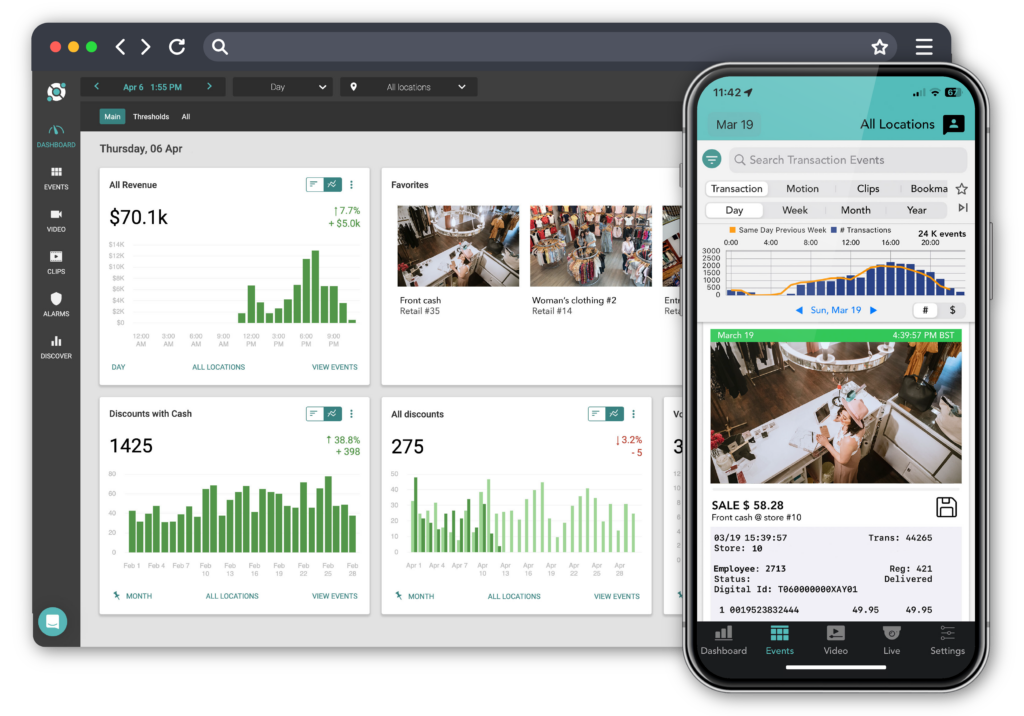 Investing in high-quality CCTV cameras is important, but without the right video management system (VMS), your security system won’t reach its full potential. A VMS doesn’t just store footage—it transforms your cameras into a smart security solution that helps you monitor, analyze, and respond to incidents in real time.
Investing in high-quality CCTV cameras is important, but without the right video management system (VMS), your security system won’t reach its full potential. A VMS doesn’t just store footage—it transforms your cameras into a smart security solution that helps you monitor, analyze, and respond to incidents in real time.
With Solink’s cloud-based VMS, your security system becomes more than just a passive recorder. Our platform integrates video with business data, allowing you to search footage instantly, detect suspicious activity, and receive real-time alerts on unusual transactions or movement. Whether you’re managing one location or hundreds, Solink’s remote access lets you view live and recorded footage from anywhere, ensuring you’re always in control.
Traditional security systems make reviewing footage time-consuming and inefficient. Solink eliminates that frustration with smart search tools, AI-driven insights, and motion detection analytics, helping you find the exact moment you need in seconds. Plus, with secure cloud storage, you never have to worry about lost or tampered footage.
Your cameras are only as effective as the system managing them. Pair them with Solink’s VMS to turn your security into a proactive, data-driven tool that protects your business and improves operations. Schedule a demo today to see how Solink can make your cameras smarter and your business safer.
Key Solink features for your business camera system needs:
- Search and save video footage
- Heat mapping capability
- Zone tracking
- POS connectivity
- Motion detection alerts
- Cloud storage for secure access
- Remote viewing from any device
- AI-driven video analytics
- Real-time security notifications
- Multi-location monitoring
- Loss prevention insights
- Employee productivity tracking
- Incident reporting and sharing
- Integration with alarms and sensors
- Easy video clip export and sharing
Book a demo to learn more about how Solink’s AI can help you stay ahead of security threats.
Schedule a product demo with our experts